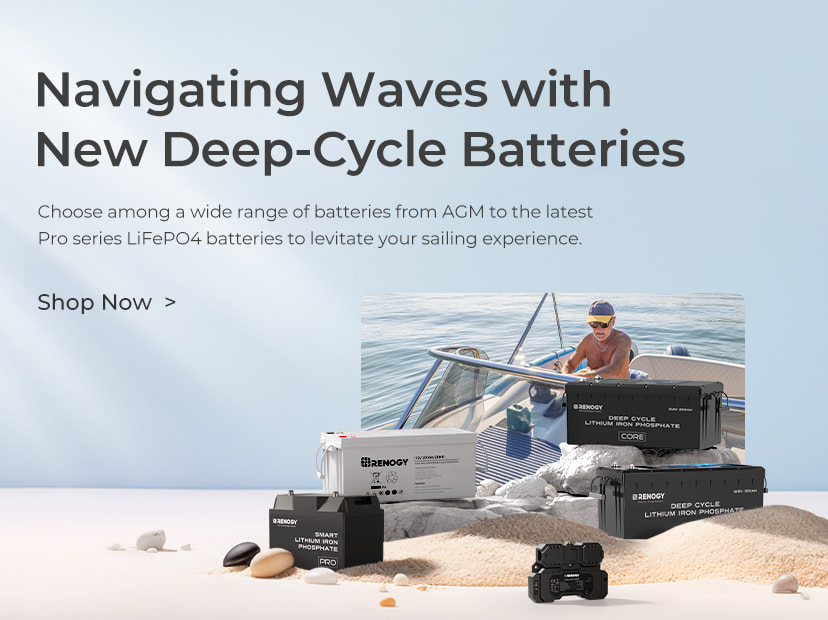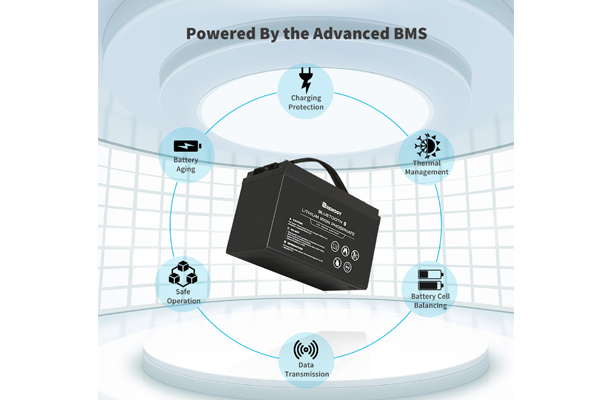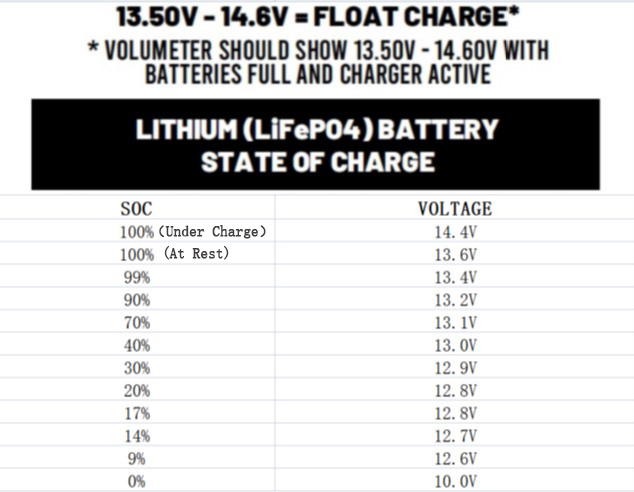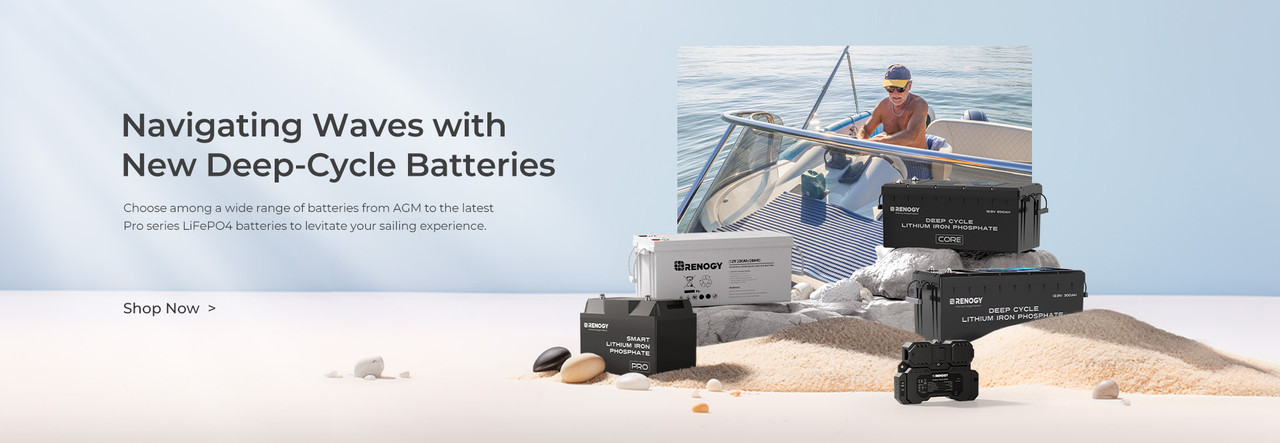Optimal Voltage Levels for a Fully Charged 12V Battery
Optimal Voltage Levels for a Fully Charged 12V Battery
If you’re unsure about the charge level or the reliability of a 12V battery, you might want to manually measure its charge level. In order to do this, you’ll want to make sure that the battery is ‘at rest’ (with nothing actively charging it), and then use a tool called a multimeter to measure the charge across the two contact points.
The results might be surprising, however. Is it normal to have a charge above 12V on a 12V battery? ( Spoiler: You’d better!) Are the readings of a 12V lithium based battery very different from the old lead acid batteries? And at what level should you be concerned about the battery’s overall health?
Let’s cover all of these topics step by step, so that you know for certain the working state of your 12V battery.
- How To Measure A 12V Battery?
- What Should A 12 Volt Battery Read When Fully Charged?
- What Voltage Is Too Low For A 12 Volt Battery?
- What Voltage Is Too High For A 12V Battery?
- State Of Charge For 12 Volt Lithium-Ion Batteries
- 12v Battery Levels For Lithium-Ion While Charging
- How To Maintain A 12V Battery Life?
How To Measure A 12V Battery?
1. Ring the battery to a resting state by disconnecting it from its circuit. This usually involves removing the clamps from the positive and negative terminals.
2. Set your multimeter to the closest available setting above 12V. For most meters, this will be the 20V setting.
3. Make sure you are only holding the shielded plastic part of the multimeter’s probes! Remove all hanging jewelry from your hands, wrists and arms, and keep any rings away from metal contact points. Keep the working area as dry as possible, and wear shoes with non-conductive soles.
4. Touch the metal part of the red probe to the positive terminal. Touch the metal part of the black probe to the negative terminal. The readout will be your battery’s voltage at rest.
For optimal solar system efficiency, we highly recommend the Renogy Battery Monitor. This excellent device is the perfect addition to any Aussie solar setup. With its ability to monitor voltage, accurately measure battery capacity and degradation rate, and protect against over-discharging, you can enjoy hassle-free monitoring of your solar system's performance. Don't waste time manually measuring your battery voltage - upgrade to the Renogy Battery Monitor and make the most of your solar setup!
What Should A 12 Volt Battery Read When Fully Charged?
While a healthy, fully charged lead acid battery might read between 12.3 Volts and 12.6 Volts at rest depending on charge level (with 12.6 being fully charged), these levels are different for modern lithium batteries!
Let’s have a look at 12Vlithium iron phosphate batteries, such as the Renogy lifepo4 battery, often used in solar applications. A fully charged 12V lithium iron phosphate battery should read between 13.4 Volts and 13.6 Volts at rest. However, it's worth noting that these readings may vary depending on the specific manufacturer and model of the battery.
Furthermore, it's important to keep in mind that the voltage readings for a lithium iron phosphate battery will fluctuate as the battery is discharged and charged. For example, a half-charged battery may read between 13.1V and 13.2V, while a quarter-charged battery may read between 12.8V and 12.9V. It's also worth noting that a 99% charged battery will read 13.4V, and a 93% charged battery will read 13.3V.

A 13.6V reading at rest would indicate a newer, fully charged lithium iron phosphate battery, while older units might read 13.5V. As soon as they have any draw at all, this figure falls away quickly. A 99% charged battery will read 13.4V, and a 93% charged battery will read 13.3V.
Therefore, it's essential to take voltage readings at different states of charge to get a better understanding of the battery's health and performance. Always refer to the manufacturer's specifications for the specific battery model for the most accurate information.
What Voltage Is Too Low For A 12 Volt Battery?
Note that the voltage level considered "too low" is the threshold for triggering a warning to protect the batteries from undervoltage. This helps ensure that your battery stays healthy and performs optimally. For a 12v lithium battery: It is important to monitor the voltage while charging devices and ensure that it does not drop below 10Volts. Otherwise, there’s a potential problem.For the typical old-school lead acid battery, you should be seeing at least 12.3V.
When your battery’s ‘discharged’ voltage gets too low, it might have suffered too much wear and tear to be reliable. We’ll talk about stress factors such as temperature and depth of discharge shortly. If your battery’s voltage gets too low, it will have trouble maintaining a full charge for long, it will charge less efficiently, and it will drain much faster. Eventually, it will become completely unfit for use.

What Voltage Is Too High For A 12V Battery?
Also, we’re talking about a warning trigger to protect batteries from overvoltage here. Active batteries, particularly while being charged, have an entirely different voltage profile.If the voltage for your lithium iron phosphate battery is at or above 14.8 Volts, you might have a problem. The same can be said for lead acid batteries at or above 12.9 Volts.
Charges at the higher end of a battery’s range do tend to shift more rapidly, as noted in the ‘fully charged’ section. So a 0.1V buffer is reasonable. But once you get into the 0.2V and 0.3V range of variance, you might have a significant overcharge problem. That might indicate a faulty charge controller, or a faulty battery.
Whether a battery's voltage drops too low or rises too high, it can lead to damage and reduced lifespan of the battery. Luckily, our 100ah lithium battery and 200ah lithium battery are equipped with a Battery Management System (BMS) that can help protect the battery from undervoltage or overvoltage.

State Of Charge For 12 Volt Lithium-Ion Batteries
For a typical, healthy 12V lithium-ion battery, you can use this table to determine its approximate state of charge at rest and when it's time to recharge the battery:

The battery voltage values corresponding to the above State of Charge (SOC) values are typical values obtained by constant discharge at a discharge rate of 0.2C (such as 100AH battery with 20A discharge) in a 25°C environment. They are for reference only, and the actual values may vary due to different charging and discharging rates, battery specifications, usage conditions, and measurement methods. In addition, battery voltage is not the most accurate indicator of battery capacity, and factors such as battery capacity, temperature, usage time, and the balance of charging and discharging endpoints also need to be considered. For a more accurate understanding of the current SOC of the lithium iron phosphate battery, it is recommended to communicate directly with the battery through a remote control screen or app.

Note the sharp drop-off towards the end, after dipping below 12.9V. This is an indication that the state of charge is changing rapidly, which can cause undue wear and tear on the battery.
We measure the recommended minimum state of charge of a battery by its suggested depth of discharge. Most lithium-ion batteries suggest a maximum of 80% depth of discharge. That means if you keep the battery at least 20% charged, you’ll prolong its overall lifespan.
The operating temperature can also dramatically impact the charge rate, charge measurement, and lifespan of a battery. At rest, the suggested optimal operating range is 73.4 ± 9℉ or 23 ± 5℃.
12v Battery Levels For Lithium-Ion While Charging
You can also measure the ‘charging’ voltage of a lithium-ion battery if you leave it hooked up to an active power source. Make sure you’re taking all of the precautions mentioned in the measuring section above!
The voltage profile will depend on the specific battery, but for your typical iron phosphate batteries, the range is 14.4 ± 0.2V. In other words, you should monitor between 14.2V and 14.6V while the battery is actively charging. Anything less might just be a trickle charge, if it charges at all. Anything more might be charging the battery at a pace that is outside its normal safety margins!
The operating temperature of these units changes during charging and discharging states. The typical charge temperature is between 41 and 113℉, or between 5 and 45℃. The typical discharge temperature is between -4 and 122℉, or between -20 and 50℃. Anything outside these measurements might be dangerous, or may dramatically decrease the battery’s lifespan and functionality.
How To Maintain A 12V Battery Life?
As we’ve mentioned, keep your depth of discharge below 80% whenever possible for lithium-ion units to maintain a maximum lifespan. Suggested depth of discharge for lead acid is much more strict, often in the 50% range.
If charging with solar, make sure you use the proper charge controller for your solar array. Otherwise, you risk damage to the battery, the panels, and the electrical system. If charging with an alternator, shore power, or generator, make sure to use a proper battery charger to maintain the correct charge voltage and avoid inrush current issues.
Try to maintain temperatures within the ranges suggested in the state of charge and charging sections above.
Finally, if you have any questions about the kind of battery you should be using, solar charging, or battery chargers and controllers, contact Renogy. We’ll be happy to suggest the right setup for your particular situation.
Click on the picture, join in the promotion right away
Related articles:
2023 Solar Batteries Guide For Home Use In Australia
How Long Do Deep Cycle Solar Batteries Last?
Everything You Need To Know About Lithium Battery Charging Cycles
Choosing The Best Solar Battery: AGM Vs. Lithium Battery
Smart Lithium Iron Phosphate Batteries For Solar: What Are The Benefits?








